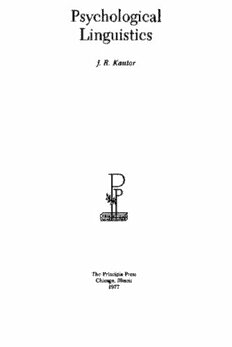
Psychological Linguistics PDF
Preview Psychological Linguistics
Psychological Linguistics ]. R. Kantor ThePrincipiaPress Chicago,Illinois 1977 Copyright© 1977byThePrincipinPress. 5743S.KimbukAvenue Chicago,Illinois“37 ISBNmines—53.3 IN MEMORIAM Edward Sapir 1884-1939 EMINENT SCHOLAR NOBLE MAN Contents PREFACE SECTION ONE Salient Problems of Psychological Linguistics 3 [. TheMultiplexityof Linguistics TheIsolationofPsychologicallanguageEvents, 3;Criteriaforhoisting DataofPsychologicalLingubt'ls,3;SchemaforDiEerentiatingLinguistic ThingsandEvents, 4;TentativeIdentificationofLinguisticThingsand Events.5;I.Authentic PsychtbgimlLanguage,5;A. Referential Language,5;B.Surrogativelanguage,5;C.Gesture]langmge,6; II. ParapsycologicalLanguage,8;A.VerbalFormuhe,6;B.Speech - Derivatives.7;C.PotentialSthuliforlanguage,7;III.Nonpsychologicai orThingLanguage, 7;A.SignandSymbols,7;B.TextualMaterials.8; C.Inscriptions, 8;D.LinguisticSystems,8;E.StandardSpeech,8; F.ConstructsorSpeechDescr'ltions.9;SemanticProblemsin Language Study,9. 12 II. Linguistic Complex Analyzed: ComponentsCompared SpecializationinLinguistics, 12;Psychological.andGeneralLinguistics, 12;and Physiologicallanguage, 14;andSociologicalLanguage, 14;and Anthropological language, l6;andLexicology, l7;and Phonetics, [8; andGrammar, 19;ScientificPachologyandGrammar. 2.0;Psychological LinguisticsandSemiotics,23;finsndBehavior,24;SymbolsasThings andActions. 24;ActsasSymbd,25;TnadicSymbology, 25;Speechas Adaptations, 26;MonitorialSydolisn,30;EquivalenceofLinguistic Factors,31. 32 III. The Psychological Foundations of language PsychologicalPostulation,32;butch-n, 32;Behaviorism,35; lnterbehavioral Psychdogy. 36;ResponsesandResponseFunctions,36; StimulusFunctions, 36;EvolilhialOriginsofResponses 38;Evolutions] OriginsofStimuli,39,InfluenceofSettingsupon interbehavior,40;The PsychologicalOrganism and [ItrbellvioralHistory, 40;Interbehavionl HistoryFollowsBiologicalEvcflion.40;CulturalFactorsin PsychologicalDevelopment, 11;languageaslnterbehavioralEvents, 42. 46"IV. TheAnalysis of Ling-TticFields TheBasicUnitof Psychology, .;TheSegmentoflnterbeluvior, 46, lnterbehavioralSegmentsand HerbdnvioralSituations,48;Objects, StimulusObjects.andStimulusfunctions.48:Acts.Responses.and ResponseFunctions, 48;lnterHavionlMedia, 49;lnterbehavioral Settings.49;ReactionSystems.0. vii um Contents 51 V. Evolution of Psychological Linguistics Originsof Psychological Linguistics, 51;PsychologicalLinguisticsand Folk Psychology, 52;HerbartianPsychologyandLanguage, 52;The ShifttoVduntaristicPsychology, 53;SocialBehavioristics,54;Social Functionalism, 55;Psychological Linguisticsand Developmental Psychology. 55;Linguistic PsychologyToday. 56;Behaviorlstic linguistics, 56;Interbehavioral Linguistics, 57. SECTION TWO The Psychology of Language 61 V1. Referenh’al Language ReferentialandSymbolicalBehavior,61;The Bistimulational Hypothesis. 62;LinguisticsasNaturalScience.63;Mediativeand NarrationaiLanguage,68;Precedinglanguage, 70;Accompanying Language.70;FollowingLanguage, 70;SubstituteLanguage. 71: Referor andRefereeLanguage. 71:ExpressiveandCommunicative Language,72;Varietiesof LinguisticSituations, 72. 75 VII. Nonreferential Language:SymbolicInterbehavior Referentialvs. NonreferentialLanguage, 75;SimpleandComplex SymbolicInterbehavior, 76;SimpleSymbolicBehavior Segments,76; ComplexSymbolicBehavior Segments,77;Symbolicand Referential BehaviorCompared,80;ThreeSourcesofSymbolicBehavior, 83; ManipulatingObjects, 83;FixatingVocal Behavior.83;Fixating Referential Responses,84;WhySymbolicand Referential LanguageAre Confused. 84;ThreeWaysof OrganizingSymbolicConnections, 87; RangeofSignifyingStimulmObjects.90;TypesofSymbolicCouples, 91;Existent-ExistentSymbols,91;ExistentoNonexistent Symbols, 91; Representant-ExistentSymbols,91;Representant-NonexistentSymbols, 92;Sign-SignificantSymbols,92;Indicator-Denotant, 92;Rangesof BehaviorandRelations, 93;NoeticandOperationalSymbolism,93; NoeticSymbolism,93;OperationalSymbolism,94;Referential and SymbolicBehaviorinSameSituation,95;Symbolism Becomes Referentialand Vice Verse, 96. VIII. Nonreferential Language: Vocal and Graphic Specificitiesof linguisticinterbehavior.99;Naming Behavior. 99; Counting, 100;RecordingBehavior. 101;Writingor inscribing Behavior, 101;EcholalicBehavior, 102;Singing, 103;Reading, 103; Nonreferential Reading, 103;Referential Reading, 104. 105 1X. Linguistic Events and Situations BehaviorSegmentsasInvestigativeTools, 105;Analytic Value of Linguistic Behavior Segments, 106;(1)CharacteristicsofLinguistic Situations, 106;(a)SignSituation, 107;(b)SignalSituation, 107; (c)SymbolSituation. 108;((1)SpeechSituation. 109;(2)Diflerentiation ofBehaviorSegmentEvents, 109;(a)Actionsof A and BBoth Referential, 109;(1))ActionsofAOnly Referential, 110;(c)A ReferentialtoC,BReactsasThoughReferential toB, 110;(d)Neither ANor BReferential with Respect toOneAnother, 110;Variationsin LinguisticSegmentsof Behavior, 110;FlveTypesof Referor Behavior Contents ix Segments, 110;(a)8;.3,8001Present, 110;(h) OnlyPraent, 110; (c)NoContactwithS], 111;(d)Functionsof inSingleObject, 112; (e)SI.SIFunctionsinSingleObjectWhich Is directlyPresent. 113; ThreeTypesof RefereeBehavior Segments, 113;(a) ,S,Inherent in 'Difl’erent PruentObjects, 113;(b)S,Absent, 114;(c) ,S,Inherentin SameObject, 114;(3)Interrelation oflinguisticand onlinguistic Events. 115;Relationshipof LinguisticEventsandlinguisticSituations, 115;Environmental InfluencesUpon LinguisticBehaviorSegments, 115;VariationsinLinguisticResponse Patterning. 118;Verbovocal Speech, 119;Whispering. 119.SubvocalSpeechPatterns, 119;Mute Speech, 119;(lassStatusSpeech. 120;TheProblemof Linguistic Distortion, 120. 121 X. The Analysis of Linguistic Reaction Systems LinguisticAnalysis:ConstructionofAbstractions, 121;Componentsof ReactionSystems, 121;(1)StimulusPhasePlusContactMedia, 123; Auditory Media, 123;TactileMedia. 124;Visual Media. 124;Compound LinguisticMedia, 124;TheBistimulationalPrinciple. 124; (2)Attentional Factors, 124;(3)DiscriminativePhase. 125;(4)Motoric Aspects. 125;(5)TheAEectiveFactors, 126;(6)ActionofReceptor Mechanism, 126;(7)TheNeural Functions, 127;(8)TheEfl'ector Mechanisms, 130;(9)TheGlandular Function, 130;(10)Muscular Functions, 131. 1335'XI. Linguistic Products mm&._fl9ducnm.mnflm¢,,l33;Long Distance Communication, 133;Waaflultural Impedimenta. 133; T33Sogr_ce§,9f_TlfingLanguage. 134;ModesofFixatingLinguistic Inter-Echavior, 134;ComplexTypesof LanguageThings, 135;Standard LinguisticSystems, 135;CeneiiI‘G‘rafimar, 135;OtherTypesof Linguistic Products. 136;(a)Written orTranscribed Speech, 136; (b)IdiomaticSpeech, 137;(c)Verbal Formulae, 137;(d)Proverbsand Maxims, 137;(e)LiteraryTexts. 137;(f)SymbolicSystems, 138; (3)ScientificDescription, 138. SECTIONTHREE Psychological Variables in Linguistic Fields 143 X11. Attending Behavior in Linguistic Fields AttendingAction Preliminary toFurtherBehavior. 143;Attentional BehaviorastheActualintionoiStimulusFunctions, 143;Attentional TheoriesCompared. 144;AttendingBehaviorinLinguisticStudies. 145. 147 X111. Perceiving Behavior in LinguisticFields OrientingProcessesFollowingAttending. 147;TheNameof Perceiving Behavior. 148;Naturalistic vs.Animistic Perceiving. 149; Wiriorin language51%“149;TheOrientational ariationlnPErceivingActs, 150;Primary Perceiving. 151;Simple Apprehension. 151;ComplexApprehension, 151;Comprehension, 152; MisconceptionsConcerningPerceptualBehavior, 152;Perceptual Behaviorand theProblemofMeanings. 153;ThePlaceofPerceivingin CommunicativeSituations. 153;Unique FeaturesofSpeechFields, 154; Superfluityin Speech, 154;Paucity of SpeechStimulation, 155. 1' Contents 156 XIV. Memorial Aspects ofLinguistic Fields MemorialBehaviorasAidsinSpeech, 156;ThePsychologyof RememberingandRelated Behavior, 156;Remembering, 156; Forgetting, 157;Memorization, 157;Reminiscing, 158;Conventional ErrorsConcurringSpeechCapacitiesandSpeechPerformances, 158; PsychologyofCapacitiesandPerformance,159;CapacitiesasFaculties andasPerformance, 159;GeneticFactorsinSpeech,160,-Psychological Adaptation and Language, 160. 161 XV.Understanding and ItsRole inLanguageSituations UnderstandingasaFoundationofSpeech,l6l;HowUnderstanding ReactionsOperateinLinguisticSituations,162;Psychology ofLinguistic MeaningandUnderstanding, 163;LiteraryAmbiguities, 164;Scientific Precision,164;PoliticalDoubletalk,165;ReligiousInterpretation, 165; LegalEnigmas, 165;ConditionsforLinguisticUnderstanding,166; AdeQuateReferenceandRefereeAction, 166,-Familiaritywith Referent,168;CompatibilitieaofLanguageSystems,167. 168 XVI. Linguistic Participants in IntellectualBehavior Fields LinguisticBehaviorSupportsIntellectualAdjustments. 168:Thinking BehaviorNot Identicalwith Language,169;Reasoninglnterbehavior. I71;IntellectualAttitudes, 172. SECTION FOUR Evolution ofLinguistic Behavior 177 XVII. Origin and DevelopmentofLinguistic Behavior LanguageinEvolution, 177;TheoriesofLanguageOrigins. 179;Origin ofLanguageandEvolution ofManldnd, 182;SpeechBehaviorand HumanEvolution, 183;NatureofHuman Nature,183;Progressive StructurationofLanguage, 184;WordsorSentences,185. 186 XVIII. Evolution ofIndividual LanguageBehavior AllegedMysteriesofIndividualSpeechEvolution,186,-Behavior Dmcriptionsvs.ConceptImposition:inIndividualLanguage Development,188;.(1)ThelmpositionalMethod, 188;(2)The ObservationalApproach, 190;WordUtteranceavs.linguistic AdjustmentsinPsychologicalLinguistics, 190;CasualandContrived LinguisticDevelopment, 191;IndividualityofLanguageDevelopment inChildren,191;TheoriesoflinguisticDevelopmentinChildren,192; LanguageDevelopmentofAdults. 198. SECTION FIVE Linguistic Variability andSpeech Deviations 197 XIX. Multilinguism and Other Speech Deviations Variability inSpeechFields, 197;Variations inLinguisticAdjustments. 197;Personality Factors, 197;UttermceFactors. 198;(a)Speech Quality, 198;(1:)SpeechDynamics, [98;Multilinguism, 199;Individual Difl’erencesAmongMultilinguals,200;IndividualDifl'erencea in MultilingualDevelopment,201;Multilingu'nm andIntelligence.202; UnfavorableAspectsofLinguisticVariation. 203;A.TheMilder Contents xi Disturbances,203;StutteringandStammering,W3;Unconventional Speech,203;9.SevereLinguisticDeprivations,204;Apraxia,‘204; Dyslexia,204;Agraphia.204;Aphasia,205;InterpretationsofAphasic Behavior,205;AuthenticAphasicTheory,207. SECTIONSIX Individualand CulturalLanguage 213 XX. LinguisticAdjustments and Linguistic Styles PrioritiesinlinguisticBehavior,213;LinguisticVariability asSpeech Styles,213;GrammarasWeStyle,214;Psychological AdjustmentsandlinguisticStandards,216;IndividualPsychologyand SocialPsychology,216;LanguageFormsandLanguageAdjustments. 216. SECTIONSEVEN Language asCommunicative Behavior and as Instrument 221 XXI. LinguisticBehaviorasInstrumentality Primary SpeechVersusVerbal Manipulation,221;Mythology and Religion,222;PhilosophicalWisdom, 223;Politics,223;Commerceand Economics,224;CompositionandLiterature,225;VerbalFormulae, 2%;TheUseandMisuseofLanguage.225;Legal Language.226; Language intheMarketPlace,2%;LanguageintheForum,227. LanguageofArgument,227. SECTION EIGHT Linguistic Observation and Experimentation 231 XXII. Linguistic Problemsand Solutions Research inPsychologicalLinguistics.231;HowDoHuman Infants BecomeSpeakersP,232;(a)HolophrasticSpeech,233;(b)Egocentrism, 233;(c)Crammatization,234;ParalinguisticInvestigation,235;Studies ofMeaning,236;ComparisonofHuman andNonhuman Language. 237;HumanandInfrahumanCommunication,240;Researchon PostulateaoiAuthenticHumanLanguage,242;Wordsvs.Sentences, 243;SpeechReception,243;A ReactionTimePlusOscillographic Study,244;Practicewith ColnedWonk,24.5;EflectofListeneron Speaker,245;Experimentswith Aphasics,246;ConcurrentAction in Speech,246. SECTION NINE Psychological Linguistics as InterdisciplinaryScience 251 XXIII. Psychological Linguisticsand General Linguistics LinguisticRelationsandlrrelations.251;I.ComparisonofGeneral LinguisticsandPsychologicalLinguistics,252;Interdisciplinary Variations. 252;(a)DivergenceinOrigin.252;(b)Divergenceof xii Contents SubjectMatterand Investigation,253;Variant AttitudeToward LinguisticProblems,254;(a)StructuralismandFunctionalism,255; (b)AttitudesTowardGrammar,256;(c)LanguageAdjustmentsand "Meaning”,259;(d)Linguistic BehaviorandDescriptiveAbstractions, 262;(e)LogicandLanguage,263;(f)VariantPostulationsandTheories, 264;II.RelevanceofGeneralLinguisticstoPsychologicalLinguistics. 267;General LinguisticOrientation,268;ComparativeLinguistics,268; HistoricalLinguistics,269;Semantics,270;111.Relevanceof Psychological LinguisticstoGeneralLinguistics.270;GeneralRelations ofPsychology toLinguistics,270;(a)ChoiceofLinguisticModels, 272; (b)ActsandThings,ContextandAuspices,273;(c)Synchronicand , DiachronicConfusions.273;(d)UniversalsandAbsolutes,275;(6)Laws andRulesofSpeech,276;(f)Syntax,TheProblem ofSerialOrder,276; (g)ParticipativeFunctionsinLanguage,278. 280 XXIV. Psychological Linguistics and Linguistic Philosophy Linguistic ProblemsofPhilosophers,280;LinguisticSolutionsof PhilosophicalProblems,281;FiveVariantsofLinguisticPhilosophy, 282;(1)ClassicalLinguism.282;(2)Linguistic Reformisrn inPhilosophy. 283;(3)PhilosophyasIdealLanguage.283;(4)InDefenseofCommon Language,284;(5)TherapeuticPositivism,284;CriticalAnalysisof Linguistic Philosophy,285;A.InsuficienciesofAnalytic Linguish’cs, 286;(1)AutonomyandFixityofWordsandSentences,286;(2)Relation ofLanguageand "Reality",286;(3)MisuseoftheConceptionand the Term “Meaning".287;(4)Mistaken NotionofMeanings.287;B. InsuficienciesofAnalytic Philosophy,288;(1)LinguisticPhilmophya TypeofMetaphysics,288;(2)MaintenanceofVenerableTraditions, 290;(3)MisconceptionsConcerningLinguistic Functions.29]; (4)InadequateLog‘c,292;C.lnsuficiencyofScientificWork and Knowledge,293;D.InsufficiencyofPsychology,293;Conclusion,294.
